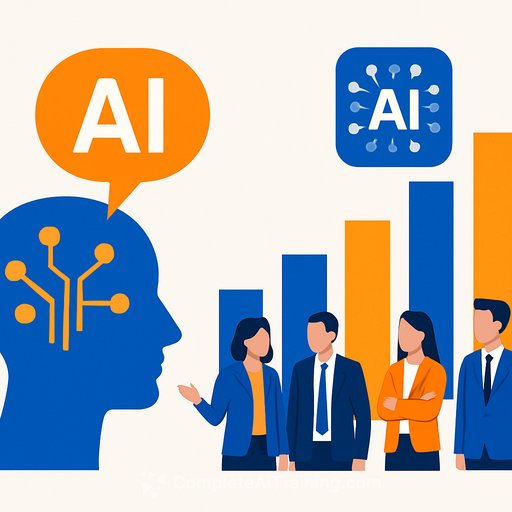AI Synthetic Personas: The Edge Sales Teams Need
Your quota doesn't care about guesswork. Static personas were fine when CRM notes and intuition were all you had. Today, AI-driven synthetic personas give you a living, learning proxy of your buyer so you can test messaging, pressure-test deals, and forecast behavior with more confidence.
Why Traditional Personas Fall Short
- They're subjective and stitched together from anecdotes or incomplete CRM data.
- They rarely capture the nuance of changing priorities, politics, or new stakeholders.
- They don't prepare reps for high-stakes objections or competitive pressure.
What Are Synthetic Personas?
Mark Osborne, CEO of Modern Revenue Strategies, explains: "AI-powered, they're dynamic representations of customers combining actual and assumed data. What's so helpful is that they're capable of learning and evolving the more companies interact with them."
These personas combine multiple inputs, then adapt as you feed them new interactions and results.
- Actual customer data: interviews, emails, call notes, recorded quotes.
- Second-party insights: competitor review sites, industry forums, social posts.
- Third-party data: demographic and psychographic research; AI estimates based on public info.
Why LLMs Make This Possible
Large language models interpret unstructured language and context, unlike scripted chatbots. They can reason across long-form text, summarize, and simulate dialogue-exactly what you need to model a buyer's reactions. For a quick primer, see IBM's overview of LLMs here.
If you're coming from traditional marketing personas, Wrike's baseline definition is useful here. Synthetic personas go several levels deeper and keep learning.
Sales Use Cases You Can Deploy Now
Discovery and Account Research
- Extract pain points from call notes and emails; have the persona rank them by urgency and ROI impact.
- Predict stakeholder goals and areas of friction across finance, IT, and legal.
Messaging, Email, and A/B Tests
- Pre-test subject lines and openings; ask the persona to score for clarity and relevance.
- Generate three first-line variants per persona segment; keep the top performer.
Objection Handling and "Hard Mode" Role-Play
- Simulate tough buyers that interrupt, challenge ROI, or bring up a competitor.
- Record sessions, tag weak moments, and turn them into coaching clips.
Deal Strategy and Multi-Threading
- List likely blockers by stage (security review, budget freeze, procurement terms).
- Draft multi-threading plans: who to involve, why they care, and how to approach.
Positioning and Offer Testing
- Osborne's team used a synthetic persona to test a dry-cleaning client's "convenience" narrative. It clarified which angle mattered most-hours, services, or same-day pricing-before spending on campaigns.
Workflow: Build a Synthetic Persona in 60 Minutes
- Collect: Pull 10-20 discovery call summaries, 50+ recent emails, 5-10 win/loss notes, and 3 competitor reviews.
- Seed: Feed that data to your LLM with a clear goal: "Build a persona of a VP Finance at a 500-2000 employee SaaS company buying [product]. Optimize for cost control and risk."
- Reverse interview: Use Geoff Woods' method-assign the model a role and have it ask you up to 5 focused questions to refine the persona.
- Calibrate: Test the persona against 3 real deals. Where it's wrong, correct it and store the update.
- Simulate: Run call role-plays, email tests, and objection drills. Log results.
- Publish: Create a one-page "persona card" with pains, triggers, metrics, buying committee map, likely objections, and top messages.
Prompt Starters
- "Act as a synthetic persona of a [Title] at a [Industry] company with [Headcount]. Ask me up to 5 questions to refine your profile. Then summarize pains, goals, decision criteria, and likely objections."
- "Given this persona, rate these 6 subject lines for clarity and relevance. Explain the top 2 and rewrite the weakest 2."
- "Role-play a 20-minute discovery call as this persona. Be skeptical. Interrupt. Press me for metrics. Afterward, grade my performance and list 3 improvements."
- "Here's a current deal summary. As the persona, identify 3 hidden risks and 3 next steps to de-risk."
Guardrails
- Privacy: Strip PII. Use customer consent where needed. Follow your security policies.
- Bias: Validate outputs against real data. Don't let assumptions become facts.
- Recency: Refresh inputs weekly for active segments; monthly for others.
- Human oversight: Product marketing and sales enablement review persona updates before rollout.
Metrics That Prove It Works
- Lift in email open and reply rate.
- Shorter time-to-next-meeting from first touch.
- Higher stage-to-stage conversion and win rate.
- Reduced cycle length; improved average deal size.
- Fewer "no decision" outcomes.
30-Day Rollout Plan
- Week 1: Pick 1 ICP segment and 10 closed-won + 10 closed-lost deals. Build v1 persona.
- Week 2: Run role-plays for your top 5 objections. Update talk tracks and email openers.
- Week 3: A/B test subject lines and first lines across 50 accounts. Log results.
- Week 4: Update persona with real outcomes. Publish the persona card. Train the team in one 45-minute session.
Keep Your Team Current
Want structured, sales-focused AI training and workflows you can deploy this quarter? Explore curated programs by job role here.
Bottom Line
Stop guessing what buyers think. Build synthetic personas, test your approach before the meeting, and walk in prepared. That's how you turn uncertainty into consistent revenue.
Your membership also unlocks:






